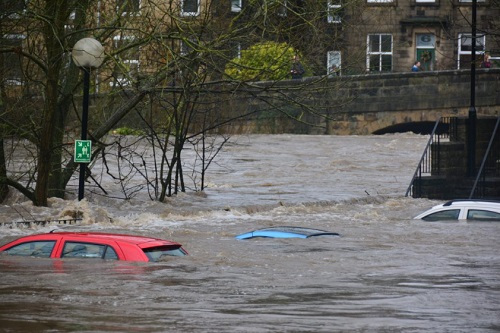The FloodFlash behavioural science series: Availability Bias

Authored by FloodFlash
Last month, we introduced our series where we will delve into different behavioural science phenomena. Read our introduction blog here if you missed it. In this article we will explore one of the most well-known behavioural science phenomena – availability bias (get it?!). We will cover what it is and what it means for flooding and flood insurance.
What is availability bias?
Many of us will assume that this information is completely accurate. However, often there are flaws in our memory, or we downplay or exaggerate it. This depends on many factors: the emotions we felt at the time, our beliefs, whether we experienced it directly or indirectly, and the reaction of others. Our memory of events influences how likely we think that event is to happen again, as well as the scale of any impact it may have.
Availability bias in action
A good example of availability bias in action is people’s fear of sharks. There are few animals that induce fear through a simple picture as much as a shark. Over half of Americans are ‘absolutely terrified of sharks’. Even more extreme, 64% of Brits would rather sharks didn’t exist at all. However, the odds of being victim to a shark attack are exceptionally low. In fact, dogs, baths, and even beds all far more likely to bring us harm. So why people so worried about shark attacks? The availability bias helps us understand why.
While it may be rare for a person to know someone who has had an encounter with a shark, but sharks are seldom shown in a positive light. Search ‘sharks’ on google and you will see countless articles about shark-infested waters and sightings of deadly species near UK beaches. A study analysing shark-related films since 1958 found that nearly all show sharks as potentially threatening to humans. Jaws had such an impact that academics have proposed the ‘Jaws effect‘ to explain how the film has changed how people view sharks.
When people think of a shark, the information that comes to mind quickly and easily is that they are dangerous and should be avoided. Availability bias therefore results in the exaggeration of how likely and how dangerous shark encounters are. As well as amplifying fears, the bias affects day-to-day decisions and beliefs.
Availability bias and climate
The ease of recalling an event depends on many factors. How recent did the event occur? How impactful was it? Was there media attention? During the record-breaking heatwave two weeks ago, people regularly compared it to the summer of 1976. This was nearly 50 years ago, and we have had hotter summers since, yet this is the year people consistently return to. Why? Partly because it was hot for such a long time – the heatwave lasted almost all summer. Partly because of the impact it had. Children at the time have fond memories of a sunny school holiday. Others will remember the Drought Act, water shortages, and forest fires. And partly because it is so often referred to and compared to by the media, meaning it is remains fresh, or ‘available’, in people’s minds. Therefore, the summer of 1976 is often the first one people think off when they think of hot summers.
Availability bias can influence how strongly people believe in climate change, or whether they believe it is happening at all. People’s perception of climate change will vary depending on the weather conditions they have most recently experienced. Ask what people think immediately after the heatwave we experienced last month and a high number will believe climate change is a significant issue. Ask immediately after a cool and wet summer, and it is likely far less will think climate change is a significant issue.
When our thinking is so connected to recent experiences, it’s hard to make a case for the long-term trends and the actions required to reduce them. Add a general lack of understanding about the complexities of climate change and the varied impacts it will have, and climate scientists and politicians face a significant challenge.
What does availability bias mean for perceptions of flooding?
The availability heuristic (mental shortcut – see part 1) means individuals tend to give a higher probability of future flooding after a flood. This occurs when flooding directly impacts people, and when people witness floods via the news or social media.
A major flood can impact how people view their risk from other natural disasters. For example, after Hurricane Katrina, Californians appeared to pay more attention to earthquake risk than before the hurricane.
However, the availability bias can reduce someone’s view of their flood risk in two main ways:
- If a flood event occurs but the impacts on an individual are minimal, their view of their flood risk may decrease. This is especially if a flood event was not as bad as expected.
- If an individual has never experienced a flood, they may have a low perception of risk. When they think of flooding, they have no memory of the direct impacts of flooding that their brain can quickly retrieve.
What does availability bias mean for flood risk and insurance?
"Flood insurance take up increases by nearly 10% immediately after a significant flood event." - Gallagher, 2014
After a flood, or another natural disaster, people will typically be more likely to get insurance, as the event will increase how at-risk they believe they are. However, this declines with time, as the memory becomes less easy to recall.
Out of sight may mean out of mind. But if flooding strikes and you don’t have resilience and insurance in place, it can leave you out of pocket.
The challenge for buyers, brokers, and insurers is to find ways to accurately represent a property’s flood risk that mitigate the impacts of the availability bias. After all, in many cases the probability of a flood happening is consistent (and often rising) regardless of flood history.
FloodFlash smart quotes are specific to each property. We provide a tailored starting point for brokers and clients based on the property’s exact flood risk and characteristics. This helps clients understand the right cover for them and understand more about the impacts a flood could have.
About FloodFlash
FloodFlash is a new type of rapid-payout flood insurance. It uses the latest data modelling and connected tech to bring parametric insurance to the mass market for the first time. The result is fast, easy and flexible cover that pays claims within days of a flood.
FloodFlash is parametric or `event-based` insurance. When buying the cover, the client chooses the depth of flooding they wish to insure against and how much they’d receive when that flood happens. When the FloodFlash sensor installed at the property detects flood water at the selected depth, the claim is paid in full. No waiting. No haggling.
FloodFlash rapid-payouts were put to the test in February 2020 when Storm Ciara swept across the UK. Claims related to the storm were paid in full within a single day. That speed of claims payment remains the fastest and best proof of mass-market parametric insurance to date gaining acclaim at industry awards and recognition from The Times, The Telegraph and the BBC.
FloodFlash operates across Britain, is headquartered in London. Floodflash is a registered coverholder at Lloyd`s of London and is authorised and regulated by the Financial Conduct Authority.

